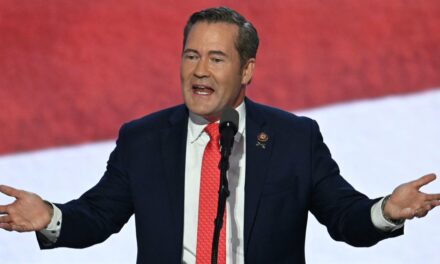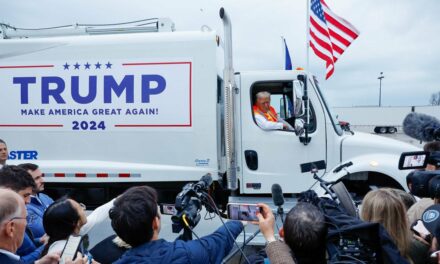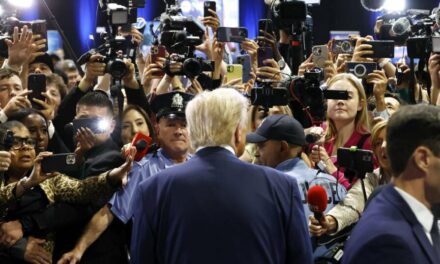We support our Publishers and Content Creators. You can view this story on their website by CLICKING HERE.
Much is being made about the decision made by a handful of newspapers not to endorse a presidential candidate this year, most notably The Washington Post.
Post owner Jeff Bezos’ money-losing newspaper is now losing a chunk of its subscribers and staff, as well. His decision is either the first step on a very long road to regaining the public’s trust or another nail in the coffin of a once widely respected institution.
There is, of course, no shortage of opinions being floated about what this means. I’ve heard more than one pundit comment on this development by first making a qualifying statement that newspaper endorsements don’t matter, that nobody is going to base their vote for president on what The Washington Post or The Los Angeles Times says.
I beg to differ.
Endorsements may not matter as much as they used to, but in a closely divided country, they could make the difference.
To most voters, perhaps, and certainly among the pundit class, such endorsements don’t matter (and in some cases steel our determination to vote against the candidate endorsed). But on the bell curve of voters, there are varying degrees of people on the ends, and there is the bulging middle—the undecided.
The closer to the middle people are, the more they are looking, consciously or subconsciously, for something to sway their decision. A newspaper endorsement—or lack thereof—may be all they need.
You might find this difficult to believe, given how consequential this election is and how different the candidates are. But we all make decisions this way—even important ones—particularly in circumstances where we don’t clearly know what to do.
Case in point: The last time I went shopping for a television, I found myself squarely in the middle of the bell curve. I went to one of those electronics superstores, where I was confronted with literally dozens of options, all beaming and blaring as if they were clamoring for my attention: “Buy me!” “Buy me!”
It was instant decision overload. My coping mechanism was to do what most of us do when confronted with a confusing choice—rather than spending hours poring over owners’ manuals and sorting through conflicting consumer reviews, I developed a heuristic—that is to say, a shortcut.
Professor Gird Gigerenzer of the Max Planck Institute for Human Development explains how heuristics work via the example of how baseball players catch a fly ball—a timely analogy during World Series week.
“It may seem that they would have to solve complex differential equations in their heads to predict the trajectory of the ball,” Gigerenzer says. “In fact, players use a simple heuristic. When a ball comes in high, the player fixates the ball and starts running. The heuristic is to adjust the running speed so that the angle of gaze remains constant—that is, the angle between the eye and the ball. The player can ignore all the information necessary to compute the trajectory, such as the ball’s initial velocity, distance, and angle, and just focus on one piece of information—the angle of gaze.”
That’s a mouthful, and while I don’t understand the physics of a fly ball, I don’t have to—precisely the professor’s point. And as a recovering marketer, I learned long ago that we can neither presume people make fully rational calculations based on articulated reasons, nor dismiss their abilities to take intuitive shortcuts based on experience, emotions, and aesthetics.
In my case, I ruled out the higher-priced television options (why pay a premium?) and eliminated the lower-priced options (too cheap is risky), which narrowed my selection down to four or five.
Rejecting a few more for picture quality reduced my choice to the beauty of the binary: this TV or that TV. It was then that I noticed something that, in an instant, made my decision simple. One TV was branded Dynex and one Toshiba.
Before I get to the punch line, which one do you think I bought?
I’ve used this illustration several times, and I’ve never heard anyone say anything other than Toshiba. Toshiba got my business because familiarity with the brand conferred on it a small, but differentiating, level of trust.
Dynex had no such reservoir of brand equity in my mind. Heuristic engaged. Sale made.
It’s true that mainstream newspapers have been hemorrhaging trust over the past several years, but they still retain some amount of equity—emotional, if not rational—particularly among people who haven’t been paying attention.
For those voters who are still undecided about this year’s presidential contest, the Hollywood image of grizzled old patriotic editors hashing out in a smoke-filled conference room which candidate would be better for America may remain as compelling as it is outdated.
It’s ironic that newspapers’ refusal to endorse either candidate has been more newsworthy than lining up behind the one everybody expected them to. That may be more influential than they intended.

 Conservative
Conservative  Search
Search Trending
Trending Current News
Current News 





